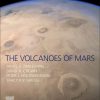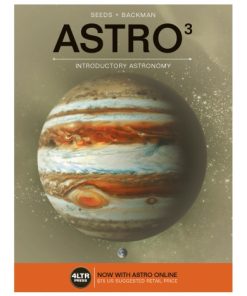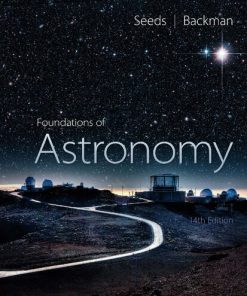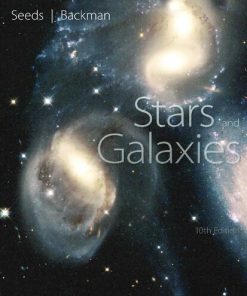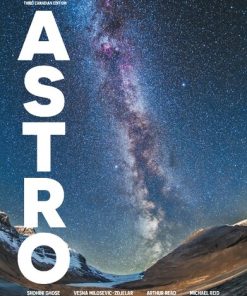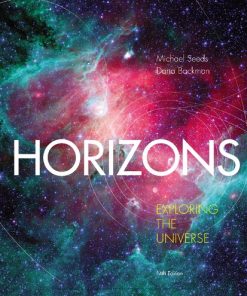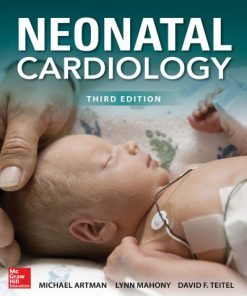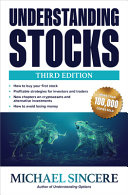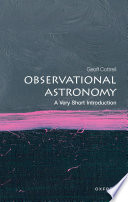ASTRO 3 Introductory Astronomy 3rd Edition by Michael Seeds, Dana Backman 9798214337821
$50.00 Original price was: $50.00.$25.00Current price is: $25.00.
ASTRO 3: Introductory Astronomy 3rd Edition by Michael A. Seeds, Dana Backman – Ebook PDF Instant Download/DeliveryISBN: 9798214337821
Full download ASTRO 3: Introductory Astronomy 3rd Edition after payment.
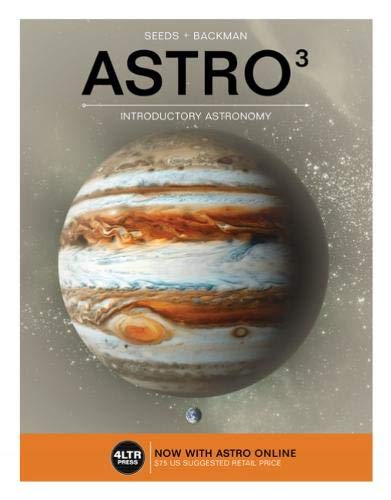
Product details:
ISBN-13 : 9798214337821
Author : Michael A. Seeds, Dana Backman
Based on cutting-edge research of student study preferences and workflows, ASTRO 3 equips you with your ideal combination of print and digital resources to help you maximize your course success. An easy-reference, paperback textbook presents course content through visually engaging chapters while convenient tear-out Chapter Review Cards consolidate key concepts into a ready-made study tool.
ASTRO 3: Introductory Astronomy 3rd Table of contents:
Chapter 1. Here and Now
1-1. Where Is Here?
1-2. When Is Now?
. Topic Summaries/Key Terms
Questions and Problems
Chapter 2. User’s Guide to the Sky: Patterns and Cycles
2-1. The Stars
2-1a. Constellations
2-1b. Star Names
2-1c. Star Brightness
2-2. The Sky and Its Motions
2-2a. The Celestial Sphere
2-2b. Precession
2-3. The Cycle of the Sun
2-3a. Apparent Annual Motion of the Sun
2-3b. Seasons
2-4. Cycles of the Moon
2-4a. Motion of the Moon
2-4b. The Cycle of Moon Phases
2-4c. Solar Eclipses
2-4d. Lunar Eclipses
. Topic Summaries/Key Terms
Questions and Problems
Chapter 3. The Origin of Modern Astronomy
3-1. Astronomy Before Copernicus
3-1a. Aristotle’s Universe
3-2. Nicolaus Copernicus
3-2a. Copernicus’s Model
3-2b. De Revolutionibus
3-3. Tycho Brahe, Johannes Kepler, and Planetary Motion
3-3a. Tycho Brahe
3-3b. Johannes Kepler
3-3c. Kepler’s Three Laws of Planetary Motion
3-4. Galileo Galilei
3-4a. Telescopic Observations
3-4b. Dialogo and Trial
3-4c. Two Ways to Understand the World
3-5. Isaac Newton, Gravity, and Orbits
3-5a. Isaac Newton
3-5b. Orbital Motion
3-5c. Tides: Gravity in Action
3-5d. Newton’s Universe
. Topic Summaries/Key Terms
Questions and Problems
Chapter 4. Light and Telescopes
4-1. Radiation: Information from Space
4-1a. Light as Waves and Particles
4-1b. The Electromagnetic Spectrum
4-2. Telescopes
4-2a. Two Kinds of Telescopes
4-2b. The Powers of a Telescope
4-3. Observatories on Earth—Optical and Radio
4-4. Astronomical Instruments and Techniques
4-4a. Imaging Systems and Photometers
4-4b. Spectrographs
4-5. Airborne and Space Observatories
4-5a. The Ends of the Visual Spectrum
4-5b. Telescopes in Space
. Topic Summaries/Key Terms
Questions and Problems
Chapter 5. Sun Light and Sun Atoms
5-1. The Sun: Basic Characteristics
5-1a. Distance and Size
5-1b. Mass and Density
5-2. The Origin of Sunlight
5-2a. Atoms and Subatomic Particles
5-2b. Temperature, Heat, and Blackbody Radiation
5-3. The Sun’s Surface
5-3a. The Photosphere
5-3b. Heat Flow in the Sun
5-4. Light, Matter, and Motion
5-4a. Electron Shells
5-4b. The Excitation of Atoms
5-4c. Measuring Velocities: The Doppler Effect
5-5. The Sun’s Atmosphere
5-5a. Formation of Spectra
5-5b. The Sun’s Chemical Composition
5-5c. The Chromosphere
5-5d. The Corona
5-6. Solar Activity
5-6a. Observing the Sun
5-6b. Sunspots
5-6c. Insight into the Sun’s Interior
5-6d. The Sun’s Magnetic Cycle
5-6e. The Babcock Model for Solar Activity
5-6f. Chromospheric and Coronal Activity
. Topic Summaries/Key Terms
Questions and Problems
Chapter 6. The Terrestrial Planets
6-1. A Travel Guide to the Terrestrial Planets
6-1a. The Scale of the Solar System
6-1b. Revolution and Rotation
6-1c. Two Kinds of Planets
6-1d. Core, Mantle, and Crust
6-1e. Atmospheres
6-2. Earth: The Active Planet
6-2a. Earth’s Interior
6-2b. Earth’s Active Crust
6-2c. Earth’s Atmosphere
6-2d. Oxygen in Earth’s Atmosphere
6-2e. A Short Geological History of Earth
6-3. The Moon
6-3a. Lunar Geology
6-3b. The Origin of Earth’s Moon
6-3c. A History of Earth’s Moon
6-4. Mercury
6-4a. Spacecraft at Mercury
6-4b. A History of Mercury
6-5. Venus
6-5a. Venus’s Atmosphere
6-5b. Venus’s Surface
6-5c. A History of Venus
6-6. Mars
6-6a. Mars’s Atmosphere
6-6b. Exploring Mars’s Surface
6-6c. Finding the Water on Mars
6-6d. A History of Mars
6-6e. Mars’s Moons
. Topic Summaries/Key Terms
Questions and Problems
Chapter 7. The Outer Solar System
7-1. A Travel Guide to the Outer Solar System
7-1a. Planets and Dwarf Planets
7-1b. Atmospheres and Interiors
7-1c. Satellite Systems
7-2. Jupiter
7-2a. Jupiter’s Interior
7-2b. Jupiter’s Complex Atmosphere
7-2c. Jupiter’s Rings
7-2d. Jupiter’s Family of Moons
7-2e. A History of Jupiter
7-3. Saturn
7-3a. Planet Saturn
7-3b. Saturn’s Rings
7-3c. Saturn’s Family of Moons
7-4. Uranus
7-4a. Planet Uranus
7-4b. Uranus’s Moons
7-4c. Uranus’s Rings
7-5. Neptune
7-5a. Planet Neptune
7-5b. Neptune’s Moons
7-5c. Neptune’s Rings
7-6. Pluto: Planet No More
7-6a. What Defines a Planet?
7-6b. Pluto and the Plutinos
. Topic Summaries/Key Terms
Questions and Problems
Chapter 8. Origin of the Solar System and Extrasolar Planets
8-1. Solar System Overview
8-1a. Size and Shape
8-1b. Terrestrial and Jovian Planets
8-2. Space Debris: Asteroids, Comets, and Meteorites
8-2a. Asteroids
8-2b. Comets
8-2c. Meteors, Meteoroids, Meteorites
8-3. The Origin of the Solar System
8-3a. The Age of the Solar System
8-3b. The Solar Nebula Theory
8-3c. Chemical Composition of the Solar Nebula
8-3d. Condensation of Solids
8-3e. Accretion of Planetesimals
8-4. The Story of Planet Building
8-4a. Growth of Protoplanets
8-4b. Bombardment of the Planets
8-4c. The Jovian Problem
8-4d. Explaining the Characteristics of the Solar System
8-4e. The History of the Atoms in Your Body
8-5. Planets Around Other Stars
8-5a. Debris Disks
8-5b. Extrasolar Planets
. Topic Summaries/Key Terms
Questions and Problems
Chapter 9. The Family of Stars
9-1. Star Distances
9-1a. The Surveyor’s Triangulation Method
9-1b. The Astronomer’s Triangulation Method
9-2. Apparent Brightness, Intrinsic Brightness, and Luminosity
9-2a. Brightness and Distance
9-2b. Absolute Visual Magnitude
9-2c. Luminosity
9-3. Star Temperatures
9-3a. Temperature Spectral Types
9-4. Star Sizes
9-4a. Luminosity, Temperature, and Radius
9-4b. Luminosity Spectral Classification
9-5. Star Masses—Binary Stars
9-5a. Binary Star Orbits
9-5b. Three Kinds of Binary Systems
9-6. Typical Stars
9-6a. Mass, Luminosity, and Density
9-6b. Surveying the Stars
. Topic Summaries/Key Terms
Questions and Problems
Chapter 10. Structure and Formation of Stars
10-1. Stellar Structure
10-1a. The Laws of Conservation of Mass and Energy
10-1b. Hydrostatic Equilibrium
10-1c. Energy Transport
10-1d. Stellar Models
10-2. Nuclear Fusion in the Sun and Stars
10-2a. Nuclear Binding Energy
10-2b. Hydrogen Fusion
10-2c. Neutrinos from the Sun’s Core
10-2d. The Pressure–Temperature Thermostat
10-3. Main-Sequence Stars
10-3a. The Mass–Luminosity Relation
10-3b. Brown Dwarfs
10-3c. Lives of Main-Sequence Stars
10-4. The Birth of Stars
10-4a. The Interstellar Medium
10-4b. Formation of Stars from the Interstellar Medium
10-4c. Formation of Protostars
10-4d. Observations of Star Formation
10-4e. The Orion Nebula
10-4f. Evidence of Young Stars
. Topic Summaries/Key Terms
Questions and Problems
Chapter 11. The Deaths of Stars
11-1. Giant Stars
11-1a. Expansion into a Giant
11-1b. Helium Fusion
11-1c. Star Clusters: Evidence of Evolution
11-2. Deaths of Low-Mass Stars
11-2a. Red Dwarfs
11-2b. Medium-Mass (Sunlike) Stars
11-2c. Planetary Nebulae
11-2d. White Dwarfs
11-2e. The Fate of the Sun and the End of Earth
11-3. The Evolution of Binary Systems
11-3a. Mass Transfer and Accretion Disks
11-3b. Novae
11-4. The Deaths of Massive Stars
11-4a. Nuclear Fusion in Massive Stars
11-4b. Supernova Explosions
11-4c. Types of Supernovae
11-4d. Observations of Supernovae
11-5. Neutron Stars
11-5a. Theoretical Prediction of Neutron Stars
11-5b. The Discovery of Pulsars
11-5c. The Evolution of Pulsars
11-5d. Binary Pulsars
11-5e. The Fastest Pulsars
11-5f. Pulsar Planets
11-6. Black Holes
11-6a. Escape Velocity
11-6b. Schwarzschild Black Holes
11-6c. Leaping into a Black Hole
11-6d. The Search for Black Holes
11-6e. Energy from Compact Objects—Jets
11-6f. Energy from Compact Objects—Gamma-Ray Bursts
. Topic Summaries/Key Terms
Questions and Problems
Chapter 12. The Milky Way Galaxy
12-1. Discovery of the Galaxy
12-1a. The Great Star System
12-1b. Size of the Milky Way
12-1c. Star Clusters and the Center of the Galaxy
12-1d. Components of the Galaxy
12-1e. Mass of the Galaxy
12-2. Spiral Arms and Star Formation
12-2a. Tracing the Spiral Arms
12-2b. Star Formation in Spiral Arms
12-3. Origin and History of the Galaxy
12-3a. Age of the Galaxy
12-3b. Stellar Populations
12-3c. The Element-Building Cycle
12-3d. History of the Galaxy
12-4. The Nucleus of the Galaxy
12-4a. Observations of the Nucleus
. Topic Summaries/Key Terms
Questions and Problems
Chapter 13. Galaxies: Normal and Active
13-1. The Family of Galaxies
13-2. Measuring the Properties of Galaxies
13-2a. Distance
13-2b. Telescopes as Time Machines
13-2c. The Hubble Law
13-2d. Galaxy Diameters and Luminosities
13-2e. Galaxy Masses
13-2f. Dark Matter in Galaxies
13-2g. Supermassive Black Holes in Galaxies
13-3. The Evolution of Galaxies
13-3a. Clusters of Galaxies
13-3b. Colliding Galaxies
13-3c. Origin and Evolution of Galaxies
13-4. Active Galaxies and Quasars
13-4a. Seyfert Galaxies
13-4b. Double-Lobed Radio Sources
13-4c. Quasars
13-4d. A Unified Model of Active Galaxies
13-4e. The Origin of Supermassive Black Holes
13-4f. Quasars Through Time
. Topic Summaries/Key Terms
Questions and Problems
Chapter 14. Modern Cosmology
14-1. Introduction to the Universe
14-1a. The Edge–Center Problem
14-1b. The Idea of a Beginning
14-1c. Cosmic Expansion
14-2. The Big Bang
14-2a. Imagining the Big Bang
14-2b. Evidence for the Big Bang—The Cosmic Microwave Background
14-2c. Particles and Nucleosynthesis—The First Seconds and Minutes
14-2d. Recombination and Reionization—The First Thousands and Millions of Years
14-3. Space and Time, Matter and Energy
14-3a. Looking at the Universe
14-3b. Cosmic Redshifts
14-3c. Model Universes
14-3d. Ordinary Matter and Dark Matter
14-4. Twenty-First-Century Cosmology
14-4a. Inflation
14-4b. Acceleration of the Expansion
14-4c. Dark Energy and Acceleration
14-4d. The Universe’s Future
14-4e. Origin of Structure
14-4f. Curvature of Space-Time
. Topic Summaries/Key Terms
Questions and Problems
Chapter 15. Life on Other Worlds
15-1. The Nature of Life
15-1a. The Physical Basis of Life
15-1b. Information Storage and Duplication
15-1c. Modifying the Information
15-2. Life in the Universe
15-2a. Origin of Life on Earth
15-2b. Deep Time and the Evolution of Life
15-2c. Life in Our Solar System
15-2d. Life in Other Planetary Systems
15-3. Intelligent Life in the Universe
15-3a. Travel Between the Stars
15-3b. Radio Communication
15-3c. How Many Inhabited Worlds?
. Topic Summaries/Key Terms
Questions and Problems
Appendix A. Units and Astronomical Data
The Metric System and SI Units
Temperature Scales
Astronomy Units and Constants
Appendix B. Observing the Sky
Using Star Charts
Star Charts
Appendix C. Celestial Profiles
Celestial Profile 1: Mercury
Celestial Profile 2: Venus
Celestial Profile 3: Earth
Celestial Profile 4: Mars
Celestial Profile 5: Jupiter
Celestial Profile 6: Saturn
Celestial Profile 7: Uranus
Celestial Profile 8: Neptune
Celestial Profile 9: The Sun
Celestial Profile 10: The Moon
H–R Diagrams
Astro Online—It’s All in There!
Working with ASTRO Online
Appendix D. Math Reference Cards
Magnitudes
The Small-Angle Formula
Circular Velocity
The Powers of a Telescope
Blackbody Radiation
The Doppler Formula
Hydrogen Fusion
Parallax and Distance
Absolute Magnitude and Distance
Luminosity, Radius, and Temperature
The Masses of Binary Stars
The Mass–Luminosity Relation
The Life Expectancies of Stars
The Hubble Law
People also search for ASTRO 3: Introductory Astronomy 3rd:
introductory astronomy and astrophysics pdf
introductory astronomy
b astronomy
best introductory astrophysics book
c astronomy
Tags:
ASTRO 3,Introductory Astronomy,Michael Seeds,Dana Backman
You may also like…
Astronomy
Astronomy - Stars - Astronomical Studies & Observations
Astronomy - The Universe - Astonomical Studies & Observations
ASTRO 3: Introductory Astronomy 3rd/Canadian Edition Shohini Ghose
Astronomy - The Universe - Astonomical Studies & Observations
Horizons : Exploring the Universe Fourteenth Edition Michael A. Seeds
Medicine - Pediatrics
Business & Economics - Personal Finance
Astronomy - The Universe - Astonomical Studies & Observations



